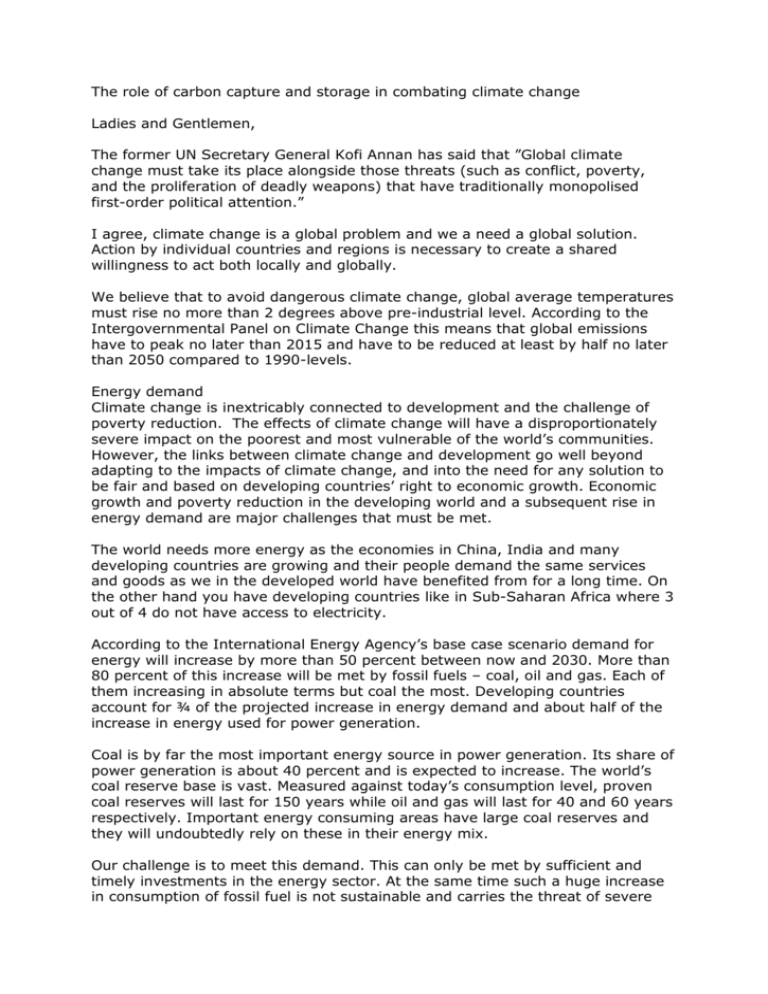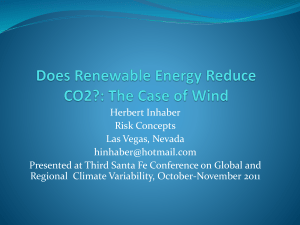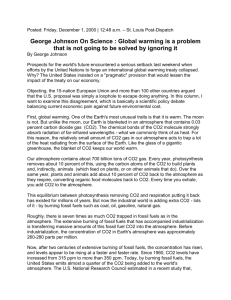The role of carbon capture and storage in combating
advertisement

The role of carbon capture and storage in combating climate change Ladies and Gentlemen, The former UN Secretary General Kofi Annan has said that ”Global climate change must take its place alongside those threats (such as conflict, poverty, and the proliferation of deadly weapons) that have traditionally monopolised first-order political attention.” I agree, climate change is a global problem and we a need a global solution. Action by individual countries and regions is necessary to create a shared willingness to act both locally and globally. We believe that to avoid dangerous climate change, global average temperatures must rise no more than 2 degrees above pre-industrial level. According to the Intergovernmental Panel on Climate Change this means that global emissions have to peak no later than 2015 and have to be reduced at least by half no later than 2050 compared to 1990-levels. Energy demand Climate change is inextricably connected to development and the challenge of poverty reduction. The effects of climate change will have a disproportionately severe impact on the poorest and most vulnerable of the world’s communities. However, the links between climate change and development go well beyond adapting to the impacts of climate change, and into the need for any solution to be fair and based on developing countries’ right to economic growth. Economic growth and poverty reduction in the developing world and a subsequent rise in energy demand are major challenges that must be met. The world needs more energy as the economies in China, India and many developing countries are growing and their people demand the same services and goods as we in the developed world have benefited from for a long time. On the other hand you have developing countries like in Sub-Saharan Africa where 3 out of 4 do not have access to electricity. According to the International Energy Agency’s base case scenario demand for energy will increase by more than 50 percent between now and 2030. More than 80 percent of this increase will be met by fossil fuels – coal, oil and gas. Each of them increasing in absolute terms but coal the most. Developing countries account for ¾ of the projected increase in energy demand and about half of the increase in energy used for power generation. Coal is by far the most important energy source in power generation. Its share of power generation is about 40 percent and is expected to increase. The world’s coal reserve base is vast. Measured against today’s consumption level, proven coal reserves will last for 150 years while oil and gas will last for 40 and 60 years respectively. Important energy consuming areas have large coal reserves and they will undoubtedly rely on these in their energy mix. Our challenge is to meet this demand. This can only be met by sufficient and timely investments in the energy sector. At the same time such a huge increase in consumption of fossil fuel is not sustainable and carries the threat of severe changes to the climate. The pattern must be changed and the technologies exist to make it possible for developing countries to move to a low-carbon economy. It is crucial that we welcome, promote and contribute to funding research, innovation and implementation of all technologies that contribute to reducing emissions. This requires increased focus on renewable energy such as hydro power, wind power, solar and biomass, as well as energy efficiency. But we must also meet the challenge of reducing the emissions from the production and use of fossil fuels. Carbon capture and storage Carbon capture and storage will complement other climate change mitigation actions by providing an option for using fossil fuels, including coal, during the transition to a low-carbon economy. It offers the potential to reduce CO2 emissions by 85 to 95 percent from coal and gas fired power plants. This technology also offers a large potential for reduction in emissions from other industrial processes. According to the Intergovernmental Panel on Climate Change (IPCC) CCS has, after energy efficiency, the second largest potential for global emission reductions. An enforced effort to stimulate development, deployment and dissemination of this technology at a global scale will in our view be vital to keep the increase in global average temperature within 2 ˚C. Some believe that carbon capture and storage should not be developed because it – allegedly - prolongs the use of fossil fuels and/or steals attention and funding from renewables. I disagree. We need a broad portfolio of technologies and measures. Fossil fuels will be the main energy source for many decades to come. Thus we need carbon capture and storage as well as more renewables and energy efficiency. We are all part of the total pattern of consumption. The beneficial effects of introducing energy efficiency in homes, public and business buildings and in industry is often underestimated. Energy efficiency should be a key factor both in meeting the challenges of energy demand and climate change mitigation. According to the International Energy Agency the global potential for energy saving is massive. But to trigger this we need millions of individuals and households to actively make changes. It goes without saying that this is not an easy task. We need to implement policies that promote this change. We also have ambitious targets for renewable energy. In Norway, Enova plays a key role in this work. Enova main mission is to contribute to environmentally sound and rational use and production of energy, relying on financial instruments and incentives to stimulate market actors and mechanisms to achieve the national energy policy goals. Capture Capture technologies are in various stages of maturity. CO2 has been removed from natural gas for commercial specifications for many years; LNG production produces almost pure streams of CO2 as a by-product – similar for ammonia production. On the other end of the spectre you have capture of CO2 from the exhaust gases from fossil fuelled power generation where the technologies are expensive and more immature. The Norwegian government and the oil company StatoilHydro have signed an agreement to establish a full-scale CO2 capture and storage plant in conjunction with a combined heat and power plant at Mongstad at the west coast of Norway. In order to reduce technical and financial risk, the project will progress in two stages. The first stage covers construction and operation of a capture testing facility, which will be operational by 2011. It will have capacity to capture at least 100 000 tons of CO2 per year. The second stage, i.e. full-scale capture of approximately 1.5 million tons of CO2 per year, shall be in place by the end of 2014. Transport Both Germany and Norway have extensive experience of transporting natural gas via pipelines. We have legal regimes and safety standards that ensure the maximum environmentally safe transport. The transportation of CO2 is very similar to the transportation of natural gas. Storage CO2 could be stored in reservoirs onshore or offshore. The Norwegian petroleum industry has extensive experience in storing CO2 in geological structures offshore. Since 1996, one million tons of CO2 per year have been separated from the gas production on the Sleipner field in the North Sea and stored in a geological formation 1,000 meters below the seabed. Multinational research projects have collected relevant data in the formation, and developed and demonstrated prediction methods for the movement of the CO2 for many years into the future. The data show the precise subsurface location of the CO2 plume and confirms that there is no sign of leakage. In the Snøhvit field in the Barents Sea, 700,000 tons of CO2 will be separated annually from the natural gas and reinjected and stored in a geological formation 2,600 metres under the seabed The combined transport and storage experiences of our two countries and the legal regime and safety standards Germany has in place to ensure the maximum environmentally safe transport and storage of natural gas should be used as guidance for our work on CO2-storage. ----------------------To sum up: To reach our goals we need renewable energy efficiency, as well as reducing the emissions from the production and use of fossil fuels. Carbon capture and storage technology is vital to keep the increase in global average temperature within 2 ˚C. An enforced effort to stimulate development, deployment and dissemination of this technology at a global scale will only be met through international cooperation











